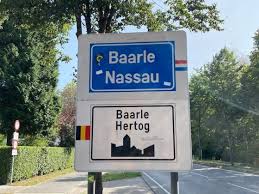Trivia of the week. Amaze you friends. Bore your family. Drone on and on. See below.
When is an international border not a border at all? There are enclaves, oh hum, yes, we all know that. But do we all know about exclaves, yes, and counter-exclaves. Fascinating, yes?
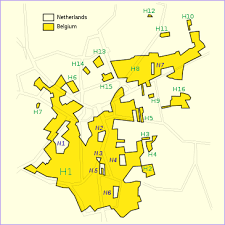
Belgium and the Netherlands were once a single entity called the Spanish Netherlands. Within that unity there were all sorts of medieval fiefdoms compounded by political matrimony and varied laws of inheritance, Papal territories, duchies, principalities, free cities, much of it tracing back to Charlemagne. Spanish hegemony had left all those pieces alone to concentrate on collecting taxes and flanking the French. In the centuries the lords and ladies had swapped acres here and there, bought and sold some, left others as inheritances, and traded land back and forth in their domains. Then in a long series of conflicts the Spanish left and later at the Congress of Vienna in 1815 Belgium and the Netherlands divided into two distinct, sovereign nations – one a monarchy and one a republic – with an international border between them. Almost….
In 1815 not all of the rival claims to territory could be resolved and the great powers of the day, having divided the two, had no interest in such fine details in a couple of brand-new minor countries and left them dangling. Despite repeated efforts since then, a few of them continue to dangle to this day. Read on for enlightenment.
Baarle-Nassau is an incorporated municipality in the southern Netherlands near the border with Belgium, but NOT on the border. It is about sixteen (16) kilometres from the border. Yet some of it is in Belgium, yet it is wholly within the Netherlands and yet I repeat: some of it is ‘of’ though not ‘in’ Belgium. Sit down and take a deep breath.
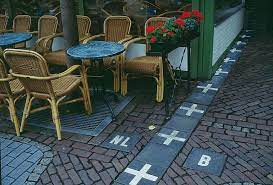
Quiet in the back! It has nothing to do with diplomatic territory. There is no embassy in this hicksville.
Based on medieval practice, royal decree, rule of law, sanctified by the Roman Catholic Church, there were numerous exclaves (look it up as above) of a Belgian municipality called Baarle-Hertog within Baarle-Nassau. For the purposes of this exposition from now on let us refer to the Dutch community as Nassau and the Belgian one as Hertog. Make a note of that for the final examination. The fraternity brothers will want to copy that later when they recover from Saturday’s hangover before starting on Sunday’s after chapel.
With a similar basis in ancient ritual, church law, taxation, and inheritance Hertog in its turn contains within its constituents counter-exclaves of Nassau. While there are several maps that show this situation, none that I found make it especially clear. But I have included the best of the ones I found.
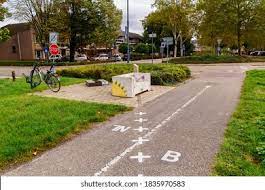
There are 22 separate Belgian exclaves in Nassau, some consist of a single residence, others are grassland, or one side of a street of shops. Within these 22 Belgian exclaves there are in turn 7 separate Dutch counter-exclaves, each within a Belgian exclave. Following so far? If not go back to the beginning and move your finger along the text very slowly. The border of these claves, en-, ex-, and counter-ex, run through buildings, between houses on the same side of street, and along the loading dock of a wine shop, and so on. In one frequently mentioned case the border bisects the front door of a private home, which accordingly has two street numbers, one on each side, 7 for Dutch and 22 for Belgian.
The total population of the two mingled communities is about 12,000, and these days its main source income is tourism as people come there to see the oddities. Selfies abound. A zig-zag international border runs down the main street so that two shops side-by-side are in different countries, complying with different tax laws, labor legislation, opening hours, social laws that define pornography, and so on.
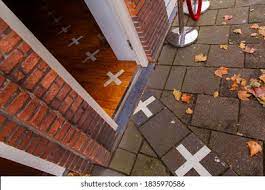
The town has one bank and the border runs through it! Business is shifted from one side of the border inside the bank to the other as required. And, yes, before the Euro all the commerce took place in two currencies, Belgian Francs and Dutch Guilders. Daylight saving times also differed. For the literal minded that meant it could be 7:00 am in the bedroom and 8:00 am in the kitchen.
A stamped letter to a Dutch address 20 meters down the street mailed in a Hertog letterbox goes to Brussels to be sorted, then to Amsterdam, and then back to Nassau in a week. In contrast the Dutch postal system is not centralised and a letter from Nassau to a Hertog address with a Dutch stamp put in a Dutch letter box is sorted locally and delivered that day to the Belgian postoffice which then delivers it to the door.
Albeit a jigsaw puzzle, surface jurisdiction is clear, but underground is another matter. If a new apartment building is put in a Dutch counter-exclave within a Belgian exclave, the apartment building will produce more sewage, must the Belgians in the surrounding exclave pay for the pipes to be upgraded too carry it? And if they do, then the pipes must meet Dutch standards at both ends to integrate from the apartment house to the surrounding Nassau. And so on. The same would apply to an apartment block built in a Belgian exclave.
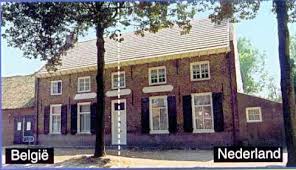
As to standards, the Dutch have strict zoning laws that lead to architectural uniformity, whereas the Belgians have no such scruples. One street will be Dutch uniform up to the border and then the houses will be ranch style next to terrace next to mock Tudor and so on. Then there is the state religion in Belgian but not so in the Netherlands. That effects church bells, church levies, Sunday opening laws, film censorship, and charity laws.
If a builder’s project straddles a boundary, then the building must satisfy two sets of building codes, labour laws, taxation… The result is that builders try to avoid that. The wine shop mentioned above is a case in point. The building is regulated by Nassau while loading dock comes under Hertog. In the case the bank both sets of regulations apply since the border bisects the bank rather than dividing into front and back. And you thought a development application for the local council was a pain.
There have been two mayors, two high schools, two of everything in this small town.
By convention, the location of the front door of a house, shop, building determines its nationality (and hence exposure to property tax, access to services, etc). If the front door is in a Belgian exclave though bulk of the house behind it is in the Netherlands, the whole property is treated as Belgian. Some property owners have arranged the front door(s) to be flexible so that it can shifted from one side to the other when taxes change.
During recent COVID lockdowns the Belgian and Dutch governments made slightly different rules, and they were dutifully reflected within the borders of Hertog and of Nassau. A Dutch restaurant was closed but the Belgian one next door remained open.
To deal with all the anomalies, at town hall they do a lot of talking at a conference table with the border drawn down the middle. But in what language do they talk, a question that became in whose language do they talk? Though local Belgians are Flemish and speak that language, the officials representing them have long insisted on speaking French. That insistence on French is partly a retaliation against the Dutch snobbery about Flemish as a dialect (of Dutch) that they cannot understand, so crude is it. After a time, the two sides settled on negotiating in English.
The European Union has avoided this problem, leaving it to the locals. Evidently they have found a way to deal with the blind-eyes of the central governments.
One wonders about the role those exclaves played in World War I when Belgian was conquered by Germany while the Netherlands remained neutral. When both countries were occupied in World War II, it unlikely that the Occupier paid any attention to these niceties, but… Well, maybe. And as soon as the uniformity imposed by the Occupier was removed, no doubt both parties reverted to their old ways. (I had long been convinced by the argument of the [Louis] Brandeis Brief that if people’s behaviour was changed by law, over generations their thinking would change. The laboratory of Yugoslavia demolished that belief where the old ways emerged.) And today one might wonder how policing occurs in this divided jurisdiction.
On the lighter side, a sit-com set in this burg would have endless possibilities for canned laughter from one side or the other.
Homework starts with the entry in Wikipedia. Then try B. R. Whyte, ‘En territories belge et à quarantie centimètres de la frontière (2004),’ a study of the Belgian and Dutch enclaves of Baarle-Hertog and Baarle-Nassau.
There are many videos on You Tube but the most informative is Stefan’s from History Hustle. Search for ‘The world’s Strangest Borders between Belgium and the Netherlands: Baarle-Hertog and Baarle-Nassau.’
P.S. There are many other oddities, I since discovered in Central Asia among the one-time Soviet republics and in the Gulf of Persia between Oman and the United Arab Emirates. You have been warned! Maritime boundaries are even more vexed.

